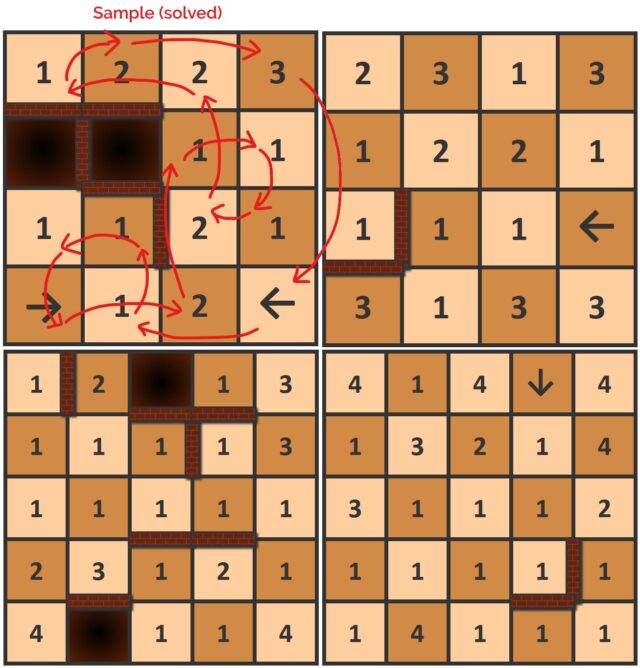Made a little progress on the game idea I’d been experimenting with. The idea is to do find a series of orthogonal (like a rook in chess!) moves that land on every square exactly once each before returning to the start, dodging walls and jumping pits.
But the squares have arrows (limiting the direction you can move out of them) or numbers (specifying the distance you must travel from them).
Every board is solvable, starting from any square. There’ll be a playable version to use on your device (with helpful features like “undo”) sometime soon, but for now you can give them a go by hand, if you like this kind of puzzle!

Looks wonderful!
Looks good! Hamiltonian mazes make for good puzzles (they’re NP-hard), and the chess motif makes it attractive. Later levels could use queens or knights to switch up the graph structure.
I did notice that the bottom right puzzle isn’t unique (solutions). I would really expect puzzles of this type to have a unique solution.
I do have some thoughts on the interface. Usually when I do a Hamiltonian circuit puzzle on paper I start with the bits with only one possible move and then try to connect these into a complete cycle. It looks like you have to move the piece continuously along the path. For me this would be much harder, and not necessarily in a fun way (it’s more memorization than logic). Maybe you can add some way to make notes to yourself before starting to move the rook. Simon Tatham’s game Signpost has a pretty good interface for this using colors and letters.
You can start anywhere you like, and yes: I’ve discovered that’s a good trick too. Often looking for a dead-end gives away only one way in and one way out, and so starting my run there makes my first few moves easy and removes a part of the grid so I don’t have to consider it later on. But yes: on the harder grids there’s a little backtracking involved (for humans!)
I’ll take a look at Signpost; sounds interesting.
I can recommend the whole Simon Tatham Puzzle collection, which includes open-source implementations of a lot of classic puzzle games. I use the Android port pretty regularly when I need a distraction for a couple minutes.
I also love the Simon Tatham Puzzle collection, and I’ve found a better place to play this set of games